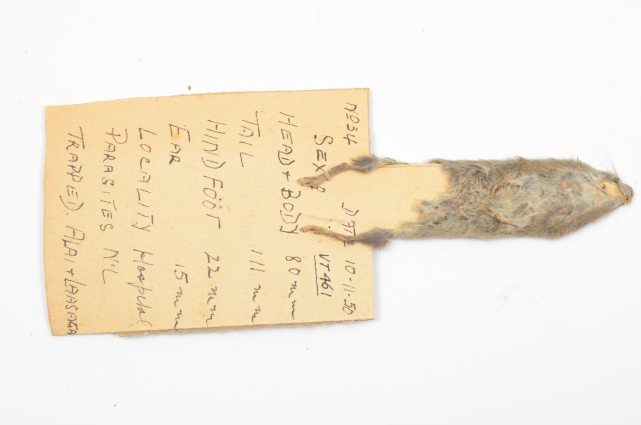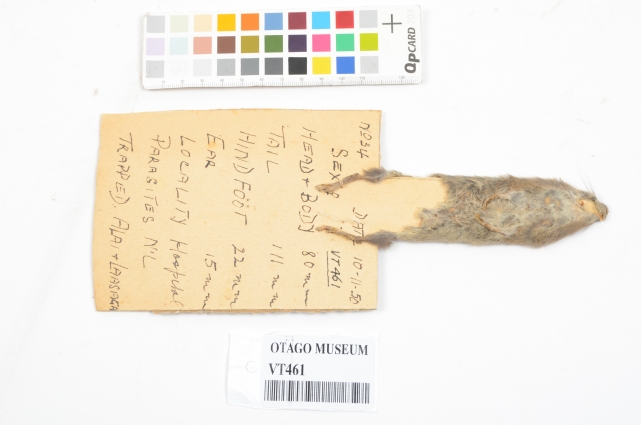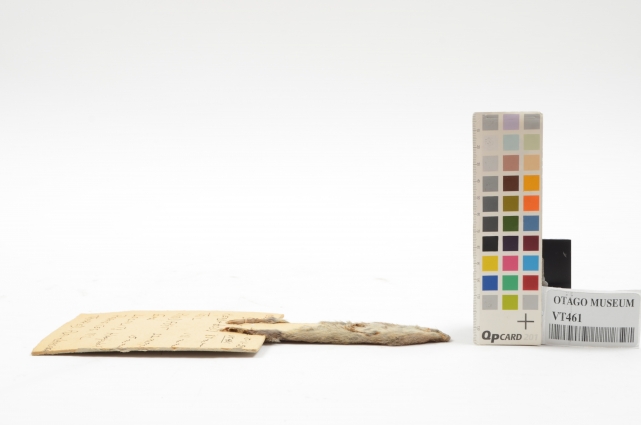Rodent, mammal skin, Muridae, Rodent, VT461
Physical Description
Study skin of a house mouse mounted on a cardboard plate. Specimen is flat and dorsoventrally compressed.
Research Notes
Two rounds of DNA extraction on the samples were not successful.
Dick Wilkins writes 25.10.2011: Our protocol for extracting DNA from the samples was fairly crude (as I said when we first got the samples, we were only aiming to see whether or not simple methods that yield loads of DNA with fresh tissue would also work with the museum skins!). We simply incubated the skin punches with a proteinase K - sodium dodecyl sulphate solution at 60oC overnight, took the supernatant as a first "extract", then extracted the skin remains with three washes of the solution, and took these as further extract samples. We have done loads of mouse samples (some from carcasses up to few years old) in this way, and the first supernatant always works well using mitochondrial DNA primers. By taking several washes, we hoped to wash out any preservatives (arsenic ??) in the skin that might have inhibited the PCR reactions.
None of our extracts, from either mouse sample, gave authentic mtDNA PCR bands!
I am 99% confident that our protocol would extract any DNA that was in the skin sample, so there are two possible explanations for our results. First, the DNA might be damaged in some way (degraded by preservatives etc ???) and not able to be PCR'd or, second, there may be inhibitors in the skin samples (arsenic or whatever) that inhibits the PCR reaction, even though the DNA is in reasonable shape. Or, it might be a combination of the two problems.
If people want to attempt these kinds of analyses in the future, I would recommend the following:
1. If possible, get a sample of skin chemically analysed to see what has been used as a preservative - probably this could be done with a very small sample.
2. Use a commercial DNA purification kit - see the paper below, and the references at the end for examples of how people deal with museum samples.
3. If possible, take a reasonably big sample of skin and experiment with variations on the extraction method, possibly adapting it to counteract the preservative.
4. Use primers for mtDNA (this is presence in high copy number - several hundred times more sensitive than nuclear DNA) and if success is not achieved in amplifying a sequence of say 500-1000bp, try to amplify a much shorter piece - say 100 to 150bp, just in case the DNA is highly degraded. —Lucy Rowe
Dick Wilkins writes 25.10.2011: Our protocol for extracting DNA from the samples was fairly crude (as I said when we first got the samples, we were only aiming to see whether or not simple methods that yield loads of DNA with fresh tissue would also work with the museum skins!). We simply incubated the skin punches with a proteinase K - sodium dodecyl sulphate solution at 60oC overnight, took the supernatant as a first "extract", then extracted the skin remains with three washes of the solution, and took these as further extract samples. We have done loads of mouse samples (some from carcasses up to few years old) in this way, and the first supernatant always works well using mitochondrial DNA primers. By taking several washes, we hoped to wash out any preservatives (arsenic ??) in the skin that might have inhibited the PCR reactions.
None of our extracts, from either mouse sample, gave authentic mtDNA PCR bands!
I am 99% confident that our protocol would extract any DNA that was in the skin sample, so there are two possible explanations for our results. First, the DNA might be damaged in some way (degraded by preservatives etc ???) and not able to be PCR'd or, second, there may be inhibitors in the skin samples (arsenic or whatever) that inhibits the PCR reaction, even though the DNA is in reasonable shape. Or, it might be a combination of the two problems.
If people want to attempt these kinds of analyses in the future, I would recommend the following:
1. If possible, get a sample of skin chemically analysed to see what has been used as a preservative - probably this could be done with a very small sample.
2. Use a commercial DNA purification kit - see the paper below, and the references at the end for examples of how people deal with museum samples.
3. If possible, take a reasonably big sample of skin and experiment with variations on the extraction method, possibly adapting it to counteract the preservative.
4. Use primers for mtDNA (this is presence in high copy number - several hundred times more sensitive than nuclear DNA) and if success is not achieved in amplifying a sequence of say 500-1000bp, try to amplify a much shorter piece - say 100 to 150bp, just in case the DNA is highly degraded. —Lucy Rowe
Sampled by Richard (Dick) Wilkins as part of a pilot study to test if DNA extracted by standard techniques for fresh samples is suitable for both mitochondrial DNA analysis and nuclear DNA analysis from Museum samples. Plucked 10 hairs and took a 1mm skin punch sample. Obj Access 090047. —Lucy Rowe
Field Collection
Trapped by Alai and La'asaga.No parasites - registration card.
Measurements
Maximum dimensions (H x W x D): 1 x 100 x 255mmLength (Head+body): 80mm
Length (Tail): 111mm
Length (Hind foot): 22mm
Length (Ear): 15mm
Sex
FemaleAll Rights Reserved








